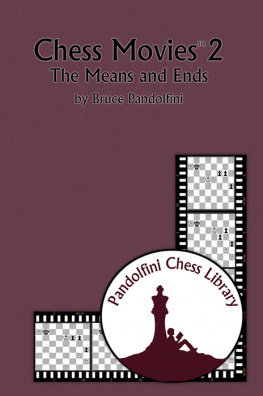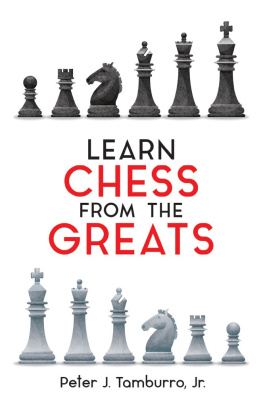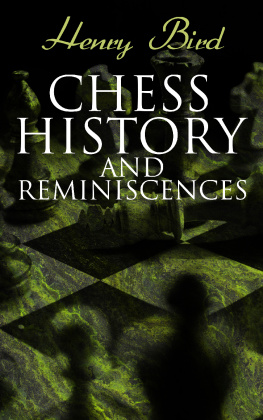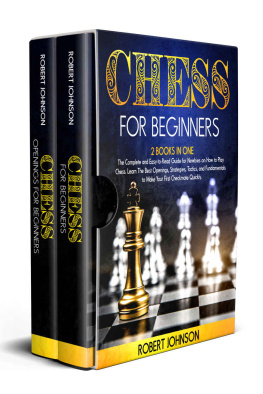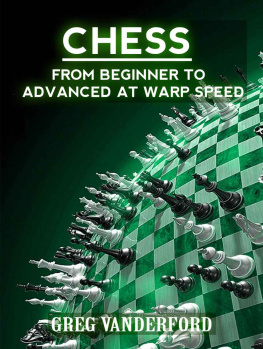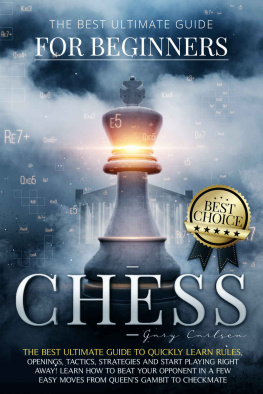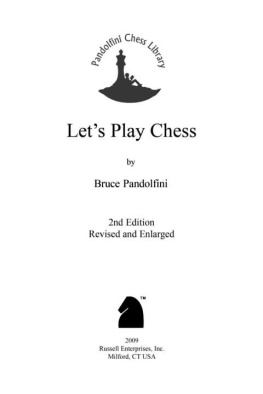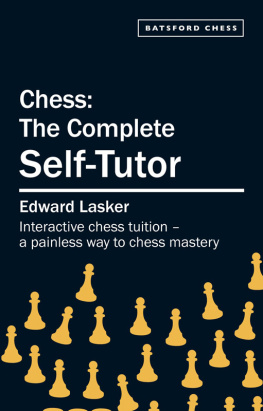
ALSO BY BRUCE PANDOLFINI
The ABCs of Chess
Beginning Chess
Bobby Fischers Outrageous Chess Moves
The Chess Doctor
Chess Openings: Traps and Zaps
Chess Target Practice
Chess Thinking
Kasparov and Deep Blue
More Chess Openings: Traps and Zaps 2
More Chessercizes: Checkmate!
Pandolfinis Chess Complete
Pandolfinis Endgame Course
Power Mates
Square One
Weapons of Chess
The Winning Way
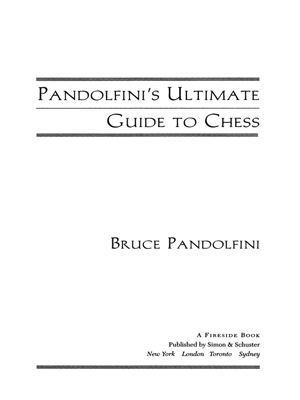

FIRESIDE
Rockefeller Center
1230 Avenue of the Americas
New York, NY 10020
www.SimonandSchuster.com
Copyright 2003 by Bruce Pandolfini
All rights reserved, including the right of reproduction in whole or in part in any form.
FIRESIDE and colophon are registered trademarks of Simon & Schuster, Inc.
Designed by Katy Riegel
For information regarding special discounts for bulk purchases, please contact Simon & Schuster Special Sales at 1-800-456-6798 or business@simonandschuster.com
Manufactured in the United States of America
10 9 8 7 6
Library of Congress Cataloging-in-Publication Data
Pandolfini, Bruce.
Pandolfinis ultimate guide to chess / by Bruce Pandolfini.
p. cm.
A Fireside book.
Includes bibliographical references and index.
1. Chess. I. Title: Ultimate guide to chess. II. Title.
GV1445.P25793 2003
794.1dc21 2003054221
eISBN-13: 978-0-7432-6098-5
ISBN-13: 978-0-7432-2617-2
www.Simonspeakers.com
ISBN 0-7432-2617-8
For my daughter Sarah, for every moment I live and beyond
LESSON 1: In the Beginning
The Moves and Rules
LESSON 2: Arming for Attack
Non-mating Tactics
LESSON 3: Defining the Goal
Mating Patterns
LESSON 4: Terms of Engagement
The Elements
LESSON 5: Staking out Territory
Opening Principles and the First Move
LESSON 6: Establishing the Neutral Zone
Blacks Response
LESSON 7: Determining Priorities
Development and the Center
LESSON 8: Starting the Campaign
Comparing Minor Pieces
LESSON 9: Digging the Trenches
Trades, Pins, and More on Minor Pieces
LESSON 10: Accumulating Advantages
Pawn Play and Weaknesses
LESSON 11: Forming Plans
Doubled Pawns, Castling, and Open Lines
LESSON 12: Evaluating and Calculating
The Middlegame, Exchange Values, How to Analyze
LESSON 13: Breaking Through
Strategy and Tactics, the Importance of Material, Avoiding Errors
LESSON 14: The Beginning of the End
Endgame Principles, Centralization, the Active King, and Pawn Promotion
LESSON 15: Approaching the Goal
The Passed Pawn and Pawn Majorities
LESSON 16: All Good Things Come to an End
The Seventh Rank, Invasion, and Simplification
Somewhere back in time, human beings invented chess. Ever since, men and women have tried to explain their fascination for, attraction to, even obsession with a checkered board and its symbolic figures. A struggle of will, a contest of intellects, the vicissitudes and intrigue of power relationships, childhood delight, and just plain funchess can stand for it all.
Chess reflects the real world in miniature. Endeavor, struggle, success, and defeatthey are part of each game ever played. Thomas Huxley, the scientist who helped Darwin write the theory of evolution into nineteenth-century philosophy, said: The rules of the game are what we call the laws of nature. The chessboard is the world and The pieces are the phenomena of the universe.
Ben Franklin, possibly the best American chessplayer of his time, also believed that the chessboard constituted a microcosm of the real world. Studying chess had practical value, he argued. Understanding the moves, rules, and structure of the game encouraged the development and training of essential intellectual skills such as inductive and deductive reasoning, long-term planning, and creative problem-solving. Plenty of present-day educators who have studied the effects of chessplaying on other disciplines have added their approval to Franklins words. Once again Old Ben was on to something ahead of the pack.
Chess is more than a game. Its a universal tale of interlocking relationships, layered thinking, analytical drive, and an intuitive sense of how things work. Its mathematical yet musical, logical but theoretical. It can be art or sport, contest or dream, fantasy or reality. Whatever the games ultimate significance, perhaps youve picked up this book hoping to go beyond the moves and rules to exploring some of the games aura and seductive mystery.
What better way to learn the universal game than through a universal learning process? Almost as soon as a child begins to talk, it starts asking questions, many unanswerable. In this book, a teacher uses Socratic methods to reveal the fundamentals of chess interactively, in give-and-take conversations with a rather challenging student. We learn through their question-and-answer sessions. Their debates over chessic possibilities make up the chapters. And each chapter constitutes an actual chess lessonon the games moves and rules; on opening, middlegame, and endgame structure; on principles, tactics, and strategy; and on anything else germane to the improvement of chess skill that might come up.
Since we learn best by doing, the teacher in this book illustrates chess essentials by using an instructionally created but perfectly natural game. White and Black, teacher and student, discuss their choices and reasoning just as players would if they were going over a real gameby considering options, variations, and possibilities throughout.
What makes their game different is that it doesnt emphasize the state-of-the-art moves grandmasters play and seldom bother to explain. Rather, it includes a normal mixture of good, reasonable, and even bad moves that inexperienced players are likely to consider. Furthermore, the moves and their respective variations, though shown in clear diagrams that everyone can understand, are also expressed conversationally, in asides and as thoughts seem pertinent. Thats just the way players converse about chess in any country of the world. To avoid confusion from the real games moves and their analytic alternates, boldface is used for actual moves, and ordinary type for moves that are possible but not played.
Most introductory chess books offer lofty principles, presenting them as if theyre inviolable absolutes in a grand narrative. But those learning the game naturally have many questions about the other side of things, when particular principles dont apply and the story takes unexpected twists and turns.
Pandolfinis Ultimate Guide to Chess offers an abundance of principles, but it also devotes time to their exceptions and subtle colorsthe very things that make the game and those who play it distinctive. Furthermore, because were dealing directly with principles and their exceptions, our teacher and student may take a second or even a third look at an idea throughout the course of the game. No lesson is wholly and completely digested in one try anyway, and the flow of the books discourse reproduces this reality. Repetition is a crucial part of typical learning, and this text aims to capture the natural feel of the learning process. To this end, the dialogue includes the constant use of instructional reinforcement, as well as the sort of typical banter and lighter moments integral to the interactive exchange of question-and-answer learning.


